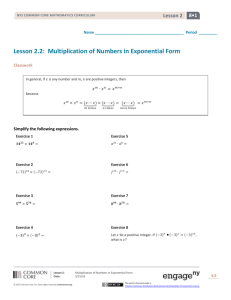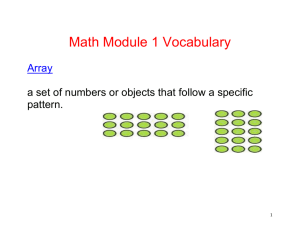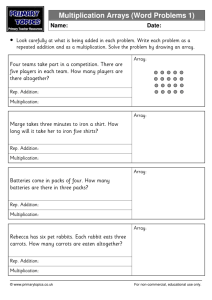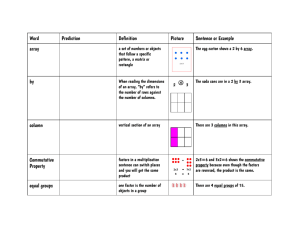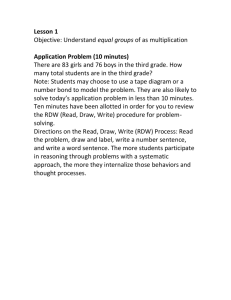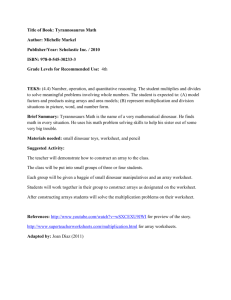Lesson 8 - Homer Central School District
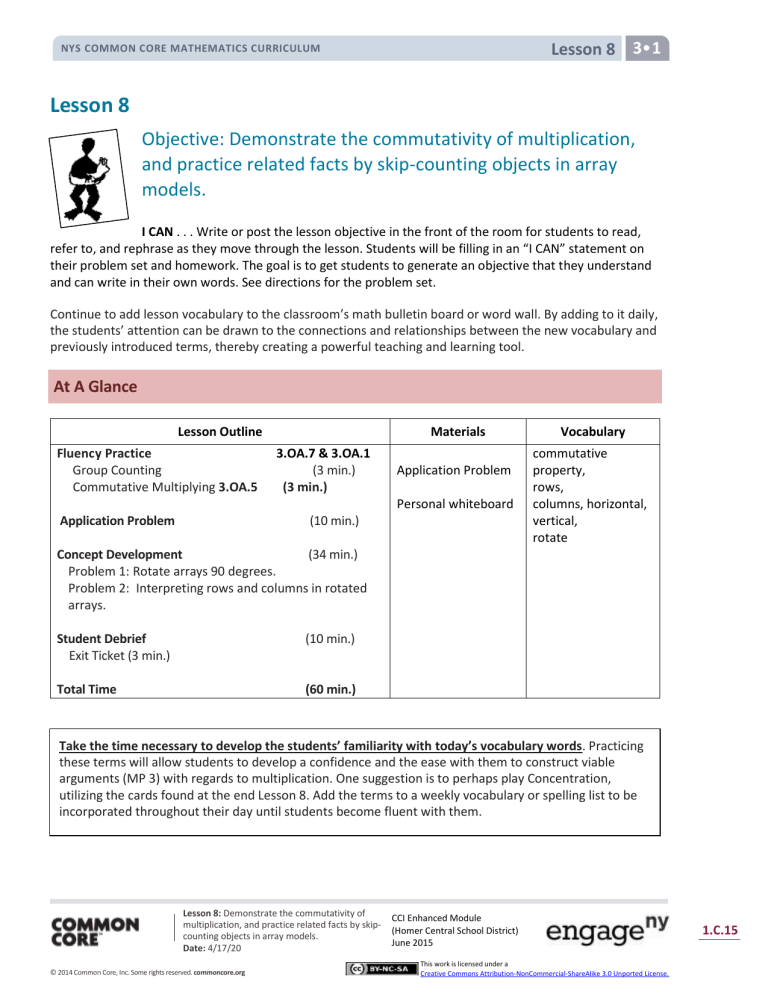
NYS COMMON CORE MATHEMATICS CURRICULUM Lesson 8 3•1
Lesson 8
Objective: Demonstrate the commutativity of multiplication, and practice related facts by skip-counting objects in array models.
I CAN . . . Write or post the lesson objective in the front of the room for students to read, refer to, and rephrase as they move through the lesson. Students will be filling in an “I CAN” statement on their problem set and homework. The goal is to get students to generate an objective that they understand and can write in their own words. See directions for the problem set.
Continue to add lesson vocabulary to the classroom’s math bulletin board or word wall. By adding to it daily, the students’ attention can be drawn to the connections and relationships between the new vocabulary and previously introduced terms, thereby creating a powerful teaching and learning tool.
At A Glance
Lesson Outline
Fluency Practice 3.OA.7 & 3.OA.1
Group Counting (3 min.)
Commutative Multiplying 3.OA.5 (3 min.)
Application Problem (10 min.)
Concept Development
Problem 1: Rotate arrays 90 degrees.
(34 min.)
Problem 2: Interpreting rows and columns in rotated arrays.
Student Debrief (10 min.)
Exit Ticket (3 min.)
Total Time (60 min.)
Materials
Application Problem
Personal whiteboard
Vocabulary commutative property, rows, columns, horizontal, vertical, rotate
Take the time necessary to develop the students’ familiarity with today’s vocabulary words. Practicing these terms will allow students to develop a confidence and the ease with them to construct viable arguments (MP 3) with regards to multiplication. One suggestion is to perhaps play Concentration, utilizing the cards found at the end Lesson 8. Add the terms to a weekly vocabulary or spelling list to be incorporated throughout their day until students become fluent with them.
Lesson 8: Demonstrate the commutativity of multiplication, and practice related facts by skipcounting objects in array models.
Date: 4/17/20
CCI Enhanced Module
(Homer Central School District)
June 2015
© 2014 Common Core, Inc. Some rights reserved. commoncore.org
This work is licensed under a
Creative Commons Attribution-NonCommercial-ShareAlike 3.0 Unported License.
1.C.15
NYS COMMON CORE MATHEMATICS CURRICULUM Lesson 8
Lesson Customization
Use this chart to customize the lesson, keeping the needs of your students in mind.
Must Do: Must be completed by ALL students to meet the objectives
Could Do: Could be completed by some students who’ve already demonstrated mastery of the objective
Extension: Students extend the application of this concept beyond the objective(s) of the lesson
Fluency Problem Set Homework
Must Do
(Objective)
3•1
Could Do
(Optional)
Extension
(Challenge)
Lesson 8: Demonstrate the commutativity of multiplication, and practice related facts by skipcounting objects in array models.
Date: 4/17/20
CCI Enhanced Module
(Homer Central School District)
June 2015
© 2014 Common Core, Inc. Some rights reserved. commoncore.org
This work is licensed under a
Creative Commons Attribution-NonCommercial-ShareAlike 3.0 Unported License.
1.C.16
NYS COMMON CORE MATHEMATICS CURRICULUM Lesson 8 3•1
Fluency Practice (6 minutes)
Group Counting (3 minutes)
Note: Group counting reviews interpreting multiplication as repeated addition. Counting by twos, threes, and fours in this activity supports work with units of 2 and 3 in this topic and anticipates work using units of 4 in Topic E.
DAILY FLUENCY is a PRIORITY:
T: Let’s count by twos to 20. Whisper the numbers, then speak them.
T: Let’s count by twos to 20 again. This time, hum the first number, and then speak it. As you hum, think of the number.
T: Let’s count by twos to 20. This time, instead of humming, think every other number.
It is important that students begin to develop fluency with the two facts at this time. Even though they have been covered previously, do not neglect their continued practice.
T: What did we just count by?
S: Twos.
T: Let’s count by fours. (Direct students to count forward and backward to 20, periodically changing directions.)
T: Let’s count by threes. (Direct students to count forward and backward to 30, periodically changing directions. Emphasize the 9 to 12, 18 to 21, and 27 to 30 transitions.)
Commutative Multiplying (3 minutes)
Materials: (S) Personal whiteboard
Note: Practicing this concept, which was taught in Lesson 7, helps students build confidence and automaticity.
T: (Project a 3 × 2 array.) How many groups of 2 do you see?
S: 3 groups of 2.
T: Write two different multiplication sentences for the array.
S: (Write 3 × 2 = 6 and 2 × 3 = 6.)
Continue with following possible sequence: 3 by 5 and 4 by 3.
T: (Write 4 × 2 = 2 × ___.) On your boards, fill in the blank.
S: (Write 4 × 2 = 2 × 4.)
Repeat the process for 9 × 5 = 5 × ___ and 3 × 6 = 6 × ___.
Lesson 8: Demonstrate the commutativity of multiplication, and practice related facts by skipcounting objects in array models.
Date: 4/17/20
CCI Enhanced Module
(Homer Central School District)
June 2015
© 2014 Common Core, Inc. Some rights reserved. commoncore.org
This work is licensed under a
Creative Commons Attribution-NonCommercial-ShareAlike 3.0 Unported License.
1.C.17
NYS COMMON CORE MATHEMATICS CURRICULUM Lesson 8 3•1
Application Problem (10 minutes)
Children sit in 2 rows of 9 on the carpet for math time. Erin says, “We make 2 equal groups.” Vittesh says, “We make 9 equal groups.” Who is correct? Explain how you know using models, numbers, and words.
Note: This problem reviews the commutativity of multiplication introduced in Lesson 7 and prepares students for Day 2 of the same concept in today’s lesson.
Copy the Application Problem Page for Lesson 8, cut the problems out, and have students paste them onto the top of the next clean page of their math journal. They can then show their work using the RW2DS strategy. Students that need additional support can also use the RW2DS template found at the end of this lesson’s materials.
Use the document camera to show students’ work that exemplifies quality written responses.
Concept Development (34 minutes)
Materials: (S) Personal whiteboard
Problem 1: Rotate arrays 90 degrees.
T: Turn your personal whiteboard so it’s vertical. Skipcount by threes 4 times and write each number.
S: 3, 6, 9, 12.
T: Draw an array to match your count. How many rows and columns does your array show? Why?
S: (Draw a 4 × 3 array. Discuss that there are 4 rows and 3 columns because there are 4 groups of 3 in the count.)
T: Skip-count and write your skip-counting down at the end of each row in your array.
S: (Students write: 3 after row 1, 6 after row 2, 9 after row 3, and 12 after row 4 in their array.
NOTES ON
MULTIPLE MEANS
OF ENGAGEMENT:
If students are very comfortable with the way an array changes depending on how it is turned, add a bit of complexity by having them imagine turning it horizontally rather than actually doing it.
Lesson 8: Demonstrate the commutativity of multiplication, and practice related facts by skipcounting objects in array models.
Date: 4/17/20
CCI Enhanced Module
(Homer Central School District)
June 2015
© 2014 Common Core, Inc. Some rights reserved. commoncore.org
This work is licensed under a
Creative Commons Attribution-NonCommercial-ShareAlike 3.0 Unported License.
1.C.18
NYS COMMON CORE MATHEMATICS CURRICULUM Lesson 8 3•1
T: Turn your board so it’s horizontal. How many rows and columns does it show now?
S: (Turn boards 90 degrees.) 3 rows and 4 columns.
MP.7
T: What is the difference between the vertical and horizontal arrays?
S: In the first array, the 4 threes were rows, and in the second, they were columns. It’s the same with the 3 fours. First, they were columns, then rows, but they still show equal groups.
T: Did the total number of dots change?
S: No.
T: So, the total and the factors stay the same. The factors just switch places. Yesterday, we learned a special name for that. It’s called . . .
S: Commutative! The commutative property!
T: Use the commutative property to write two multiplication sentences for the array.
S: (Write 4 × 3 = 12 and 3 × 4 = 12.)
T: Great! Now use the phrase commutative property to explain the arrays and multiplication sentences with your partner.
T: To make the vertical array, you skip-counted by threes 4 times. Look at your array horizontally. Tell your partner the directions for another count-by to make the horizontal array. Check your directions by writing out the count-by.
S: Skip-count by fours 3 times. (Write 4, 8, 12.)
Students practice with partners using the following examples. Partner A gives skip-counting directions.
Partner B writes the count, draws the array, and writes two multiplication sentences. Then, partners switch roles.
Skip-count by twos 3 times
Skip-count by threes 6 times
NOTES ON
DRAWING ROWS
AND COLUMNS:
Students may not immediately recognize that they do not need to redraw the corner circle to make 3 columns. After drawing rows, they already have 1 column, and, for this problem, only need to add 2 more columns. If they make a mistake, help them recognize it by encouraging them to recount their total columns.
Problem 2: Interpreting rows and columns in rotated arrays.
T: Work with your partner to draw an array that shows 5 rows and 4 columns.
S: (Demonstrate one possible process.) Let’s draw 5 circles going down to show the start of each row.
Then we can draw 4 circles to show the columns across the top. Wait, we already drew 1 column when we made the rows, so we can just draw 3 more columns.
T: Write an equation to match your array. Don’t solve it yet.
S: (Write 5 × 4 = ____.)
T: I’m going to change the problem slightly. Listen carefully and rotate your array to match: 4 rows and 5 columns.
S: (Turn boards 90 degrees.)
Lesson 8: Demonstrate the commutativity of multiplication, and practice related facts by skipcounting objects in array models.
Date: 4/17/20
CCI Enhanced Module
(Homer Central School District)
June 2015
© 2014 Common Core, Inc. Some rights reserved. commoncore.org
This work is licensed under a
Creative Commons Attribution-NonCommercial-ShareAlike 3.0 Unported License.
1.C.19
NYS COMMON CORE MATHEMATICS CURRICULUM Lesson 8 3•1
T: Write the equation for the new array. Don’t solve it yet.
S: (Write 4 × 5 = ____.)
T: Explain the difference between these problems to your partner.
S: The array turned and the factors switched places.
When the array turns, the 4 represents the rows instead of the columns, and the 5 represents columns instead of rows.
T: When we turn the array, columns become rows and rows become columns. What do we call that?
S: The commutative property.
T: Solve each of your equations by skip-counting. Write each number as you say it.
S: (Write 4, 8, 12, 16, 20 and 5, 10, 15, 20.)
Continue with the following possible examples:
7 rows and 2 columns
3 rows and 9 columns
NOTES ON
MULTIPLE MEANS OF
ENGAGEMENT:
If appropriate, provide a challenge for students by having them cover the array as they skip-count to solve.
T: (Once students have worked through the problem, write the final example in group language: 3 groups of 9 and 9 groups of 3.) Are these statements equal? Use your array to discuss with your partner how you know. (Encourage students to use any of their new vocabulary in their explanations, i.e., horizontal, vertical, columns, rows, rotate, commutative.)
Problem Set (10 minutes)
Remind students of the importance of previewing their assignment, completing the work they know how to do and then going back to check their work. Explain why the “I can” sentence frame is at the beginning of the problem set (they will also see it on the homework too). Once they’ve completed the problem set, the class will discuss how to best complete the sentence frame as a whole group during the Student Debrief.
Students should do their personal best to complete the problem set within the allotted 10 minutes. For some classes, it may be appropriate to modify the assignment by specifying which problems they work on first.
Some problems do not specify a method for solving. Students should solve these problems using the RW2DS approach used for Application Problems.
Lesson 8: Demonstrate the commutativity of multiplication, and practice related facts by skipcounting objects in array models.
Date: 4/17/20
CCI Enhanced Module
(Homer Central School District)
June 2015
© 2014 Common Core, Inc. Some rights reserved. commoncore.org
This work is licensed under a
Creative Commons Attribution-NonCommercial-ShareAlike 3.0 Unported License.
1.C.20
NYS COMMON CORE MATHEMATICS CURRICULUM Lesson 8 3•1
Student Debrief (10 minutes)
Lesson Objective: Demonstrate the commutative property of multiplication and practice related facts by skip-counting objects in array models.
The Student Debrief is intended to invite reflection and active processing of the total lesson experience.
Invite students to review their solutions for the problem set. They should check work by comparing answers with a partner before going over answers as a class. Look for misconceptions or misunderstandings that can be addressed in the debrief. Guide students in a conversation to debrief the problem set and process the lesson.
You may choose to use any combination of the questions below to lead the discussion.
Discuss the usefulness of skip-counting to solve multiplication problems.
Build fluency by having students skip-count to find answers to the following expressions without the help of an array. They can keep track of their count using fingers.
3 sixes, 6 threes
3 eights, 8 threes
5 threes, 3 fives
Discuss the meaning of the commutative property and how it relates to equal groups, columns, rows, and arrays.
Have students review their vocabulary pages with each other and then use the vocabulary cards to play Concentration, where they try to match cards and collect the most pairs.
Encourage the students to add graphic images to their vocabulary pages to assist them in remembering the meaning of their new vocabulary.
Revisit the objective and have students turn and talk with their partner about what the learning target for the lesson was. Ask students to offer suggestions on how to best complete the “I can” sentence frame with a partner or small group and then complete the sentence frame as a whole group at the top of the problem set’s first page.
Exit Ticket (3 minutes)
After the Student Debrief, instruct students to complete the Exit Ticket. A review of their work will help you assess the students’ understanding of the concepts that were presented in the lesson today and plan more effectively for future lessons. You may read the questions aloud to the students.
Before collecting the Exit Tickets, have students reflect on their understanding of the day’s concept by circling one of the three statements at the bottom.
Lesson 8: Demonstrate the commutativity of multiplication, and practice related facts by skipcounting objects in array models.
Date: 4/17/20
CCI Enhanced Module
(Homer Central School District)
June 2015
© 2014 Common Core, Inc. Some rights reserved. commoncore.org
This work is licensed under a
Creative Commons Attribution-NonCommercial-ShareAlike 3.0 Unported License.
1.C.21
NYS COMMON CORE MATHEMATICS CURRICULUM Lesson 8 3•1
Answer Key for Problem Set: Answer Key for Homework:
1a. 3, 6, 9, 12, 15
1b.
1a. 3, 6, 9, 12, 15, 18
1b.
2a. 5, 10, 15
2b.
3. 5 x 3 = 3 x 5
4a. 2 x 3 = 6
4b. 3 x 2 = 6
4c. 3 x 4 = 12
4d. 4 x 3 = 12
4e. 3 x 7 = 21
4f. 7 x 3 = 21
4g. 3 x 9= 27
4h. 9 x 3 = 27
4i. 10 x 3 = 30
5a. 15 5d. 24
5b. 27 5e. 15
5c. 24 5f. 3
6.
7 x 3 = 21
XXX
10 x 3 = 30
7. 3 x $2 = $6
6 x $2 = $12
2a. 6, 12, 18
2b.
3. 6 x 3 = 3 x 6
4a. 5 x 3 = 15
4b. 3 x 5 = 15
4c. 6 x 3 = 18
4d. 3 x 6 = 18
4e. 7 x 3 = 21
4f. 3 x 7 = 21
4g. 8 x 3= 24
4h. 3 x 9 = 27
4i. 10 x 3 = 30
5a. 18 5d. 27
5b. 15 5e. 18
5c. 27 5f. 3
6.
8 x 3 = 24
10 x 3 = 30
7. 4 x 3
₵
= 12 cents
7 x 3
₵
= 21 cents
Lesson 8: Demonstrate the commutativity of multiplication, and practice related facts by skipcounting objects in array models.
Date: 4/17/20
CCI Enhanced Module
(Homer Central School District)
June 2015
© 2014 Common Core, Inc. Some rights reserved. commoncore.org
This work is licensed under a
Creative Commons Attribution-NonCommercial-ShareAlike 3.0 Unported License.
1.C.22
NYS COMMON CORE MATHEMATICS CURRICULUM Lesson 8 Application Problem Template 3•1
Print out the application problems.
Have students glue a copy into their math journal to solve the problem and show their work.
Children sit in 2 rows of 9 on the carpet for math time. Erin says, “We make 2 equal groups.” Vittesh says, “We make 9 equal groups.” Who is correct? Explain how you know using models, numbers, and words
Module 1.8
Children sit in 2 rows of 9 on the carpet for math time. Erin says, “We make 2 equal groups.” Vittesh says, “We make 9 equal groups.” Who is correct? Explain how you know using models, numbers, and words
Module 1.8
Children sit in 2 rows of 9 on the carpet for math time. Erin says, “We make 2 equal groups.” Vittesh says, “We make 9 equal groups.” Who is correct? Explain how you know using models, numbers, and words
Module 1.8
Children sit in 2 rows of 9 on the carpet for math time. Erin says, “We make 2 equal groups.” Vittesh says, “We make 9 equal groups.” Who is correct? Explain how you know using models, numbers, and words
Module 1.8
Children sit in 2 rows of 9 on the carpet for math time. Erin says, “We make 2 equal groups.” Vittesh says, “We make 9 equal groups.” Who is correct? Explain how you know using models, numbers, and words
Module 1.8
Children sit in 2 rows of 9 on the carpet for math time. Erin says, “We make 2 equal groups.” Vittesh says, “We make 9 equal groups.” Who is correct? Explain how you know using models, numbers, and words
Module 1.8
Children sit in 2 rows of 9 on the carpet for math time. Erin says, “We make 2 equal groups.” Vittesh says, “We make 9 equal groups.” Who is correct? Explain how you know using models, numbers, and words
Module 1.8
Children sit in 2 rows of 9 on the carpet for math time. Erin says, “We make 2 equal groups.” Vittesh says, “We make 9 equal groups.” Who is correct? Explain how you know using models, numbers, and words
Module 1.8
Children sit in 2 rows of 9 on the carpet for math time. Erin says, “We make 2 equal groups.” Vittesh says, “We make 9 equal groups.” Who is correct? Explain how you know using models, numbers, and words
Module 1.8
Children sit in 2 rows of 9 on the carpet for math time. Erin says, “We make 2 equal groups.” Vittesh says, “We make 9 equal groups.” Who is correct? Explain how you know using models, numbers, and words
Module 1.8
Lesson 8: Demonstrate the commutativity of multiplication, and practice related facts by skipcounting objects in array models.
Date: 4/17/20
CCI Enhanced Module
(Homer Central School District)
June 2015
© 2014 Common Core, Inc. Some rights reserved. commoncore.org
This work is licensed under a
Creative Commons Attribution-NonCommercial-ShareAlike 3.0 Unported License.
1.C.15
NYS COMMON CORE MATHEMATICS CURRICULUM Lesson 8 Problem Set 3•1
Name: _________________________________________ Date ________________
I can ____________________________________________________
________________________________________________________
________________________________________________________
1.
a. Count by three 5 times.
_____, _____, _____, _____, _____
b. Draw an array that matches your count-by of 5 groups of 3.
2. a. Count by five 3 times.
_______, _______, _______
b. Draw an array that matches your count-by of 3 groups of 5.
3.
Use your arrays from Problems 1 and 2 to fill in the blanks below. Use the commutative property to make the equation true.
_______ × _______ = _______ × _______
Problem 1 Problem 2
4.
Skip-count to find the total for each expression and write the equation to match it.
The first one is done for you. a.
2 threes: 2 × 3 = 6 d. 4 threes: _________ g. 3 nines: ___________ b.
3 twos: ____________ e. 3 sevens: _________ h. 9 threes: __________ c.
3 fours: ___________ f. 7 threes: __________ i. 10 threes: _________
Lesson 8: Demonstrate the commutativity of multiplication, and practice related facts by skipcounting objects in array models.
Date: 4/17/20
CCI Enhanced Module
(Homer Central School District)
June 2015
© 2014 Common Core, Inc. Some rights reserved. commoncore.org
This work is licensed under a
Creative Commons Attribution-NonCommercial-ShareAlike 3.0 Unported License.
1.C.16
NYS COMMON CORE MATHEMATICS CURRICULUM Lesson 8 Problem Set 3•1
5.
Find the unknowns that make the equations true. a. 3 + 3 + 3 + 3 + 3 = _________ d. 3 × 8 = _________ b. 3 × 9 = _________ e. _________ = 5 × 3 c. 7 threes + 1 three = _________ f. 27 = 9 × _________
6.
Isaac picks 3 tangerines from his tree every day for 7 days. a.
Use circles to draw an array that represents the tangerines Isaac picks. b.
How many tangerines does Isaac pick in 7 days? Write and solve a multiplication equation to find the total.
__________________________________________________________________ c.
Isaac decides to pick 3 tangerines every day for 3 more days. Draw x’s to show the new tangerines on the array in Part A. d.
Write and solve a multiplication equation to find the total number of tangerines
Isaac picks.
__________________________________________________________________
7.
Sarah buys bottles of soap. Each bottle costs $2. a.
How much money does Sarah spend if she buys 3 bottles of soap? b.
__________ × __________ = $__________ c.
How much money does Sarah spend if she buys 6 bottles of soap?
__________ × __________ = $__________
Lesson 8: Demonstrate the commutativity of multiplication, and practice related facts by skipcounting objects in array models.
Date: 4/17/20
CCI Enhanced Module
(Homer Central School District)
June 2015
© 2014 Common Core, Inc. Some rights reserved. commoncore.org
This work is licensed under a
Creative Commons Attribution-NonCommercial-ShareAlike 3.0 Unported License.
1.C.17
NYS COMMON CORE MATHEMATICS CURRICULUM Lesson 8 Exit Ticket 3•1
Name: _________________________________________ Date ________________
Mary Beth organizes stickers on a page in her sticker book. She arranges them in 3 rows and 4 columns. a. Draw an array to show Mary Beth’s stickers. b.
Use your array to write a multiplication equation to find Mary Beth’s total number of stickers.
___________________________________________________________________ c.
Label your array to show how you skip-count to solve your equation. d.
Use what you know about the commutative property to write a different equation for your array.
___________________________________________________________________
Circle the statement that best describes you right now.
I’m still not too sure.
I’m good. I’ve got it.
I can teach this!
Lesson 8: Demonstrate the commutativity of multiplication, and practice related facts by skipcounting objects in array models.
Date: 4/17/20
CCI Enhanced Module
(Homer Central School District)
June 2015
© 2014 Common Core, Inc. Some rights reserved. commoncore.org
This work is licensed under a
Creative Commons Attribution-NonCommercial-ShareAlike 3.0 Unported License.
1.C.18
NYS COMMON CORE MATHEMATICS CURRICULUM Lesson 8 Homework 3•1
Name: _________________________________________ Date _______________
I can ____________________________________________________
________________________________________________________
________________________________________________________
Skip counting is sometimes referred to as “count by” and builds mathematical fluency. Counting by fours means that the size of each group would be
4. To count by four 9 times would sound like or be written as: 4, 8, 12, 16, 20, 24, 28,
32, and 36. Arrays help children see the relationship of commutativity meaning 9 x 4 =
4 x 9 = 36. The arrays still show identical totals; just the number of rows and columns are reversed.
9 x 4 = 36
1. a. Count by threes 6 times.
4 x 9 = 36
2. a. Count by sixes 3 times.
____, ____, ____, ____, ____, ____ b. Draw an array to match your count-by of _____ groups of 3 .
_______, _______, _______ b. Draw an array to match your count-by of _____ groups of 6.
3.
Use your arrays from Problems 1 and 2 to fill in the blanks below. Use the commutative property to make the equation true.
________ × ________ = ________ × ________
Problem 1 Problem 2
Lesson 8: Demonstrate the commutativity of multiplication, and practice related facts by skipcounting objects in array models.
Date: 4/17/20
CCI Enhanced Module
(Homer Central School District)
June 2015
© 2014 Common Core, Inc. Some rights reserved. commoncore.org
This work is licensed under a
Creative Commons Attribution-NonCommercial-ShareAlike 3.0 Unported License.
1.C.19
NYS COMMON CORE MATHEMATICS CURRICULUM Lesson 8 Homework 3•1
4.
Skip-count to find the total for each expression. Write an equation to match your count-by. The first one is done for you. a.
5 threes: d. 3 sixes: g. 8 threes:
___________________ ___________________
5 x 3 = 15 ___________________ ___________________ ___________________ b.
3 fives: e. 7 threes: h. 3 nines:
___________________ ___________________ ___________________
___________________ ___________________ ___________________ c.
6 threes: f. 3 sevens: i. 10 threes:
___________________ ___________________ ___________________
___________________ ___________________ ___________________
5. Find the unknowns that make the equations true. a.
3 + 3 + 3 + 3 + 3 + 3 = _____ b.
3 x 5 = _____ c.
8 threes + 1 three = _____ d.
3 x 9 = _____ e.
_____ = 6 x 3 f.
15 = 5 x _____
Lesson 8: Demonstrate the commutativity of multiplication, and practice related facts by skipcounting objects in array models.
Date: 4/17/20
CCI Enhanced Module
(Homer Central School District)
June 2015
© 2014 Common Core, Inc. Some rights reserved. commoncore.org
This work is licensed under a
Creative Commons Attribution-NonCommercial-ShareAlike 3.0 Unported License.
1.C.20
NYS COMMON CORE MATHEMATICS CURRICULUM Lesson 8 Homework 3•1
6. Fernando puts 3 pictures on each page of his photo album. He does this for 8 pages. a.
Use circles to draw an array that represents the total number of pictures in
Fernando’s photo album. b.
Use your array to write and solve an equation to find Fernando’s total number of pictures.
_________________________________________________________________ c.
Fernando adds 2 more pages to his book. He puts 3 pictures on each new page.
Add x’s to your drawing in Question 6, Part A, to show the new pictures
Fernando added to his photo album. d.
Write and solve a multiplication equation to find the new total number of pictures in Fernando’s album.
_________________________________________________________________
7. Ivania recycles. She gets 3 cents for every can she recycles. a.
How much money does Ivania make if she recycles 4 cans?
__________ × __________ = __________ cents b.
How much money does Ivania make if she recycles 7 cans?
__________ × __________ = __________ cents
Lesson 8: Demonstrate the commutativity of multiplication, and practice related facts by skipcounting objects in array models.
Date: 4/17/20
CCI Enhanced Module
(Homer Central School District)
June 2015
© 2014 Common Core, Inc. Some rights reserved. commoncore.org
This work is licensed under a
Creative Commons Attribution-NonCommercial-ShareAlike 3.0 Unported License.
1.C.21
NYS COMMON CORE MATHEMATICS CURRICULUM Lesson 8 Concentration Cards 3•1
Number bond
Row
Commutative
Lesson 8: Demonstrate the commutativity of multiplication, and practice related facts by skipcounting objects in array models.
Date: 4/17/20
CCI Enhanced Module
(Homer Central School District)
June 2015
© 2014 Common Core, Inc. Some rights reserved. commoncore.org
This work is licensed under a
Creative Commons Attribution-NonCommercial-ShareAlike 3.0 Unported License.
1.C.22
NYS COMMON CORE MATHEMATICS CURRICULUM Lesson 8 Concentration Cards 3•1
Column
Array
Facts
Lesson 8: Demonstrate the commutativity of multiplication, and practice related facts by skipcounting objects in array models.
Date: 4/17/20
CCI Enhanced Module
(Homer Central School District)
June 2015
© 2014 Common Core, Inc. Some rights reserved. commoncore.org
This work is licensed under a
Creative Commons Attribution-NonCommercial-ShareAlike 3.0 Unported License.
1.C.23
NYS COMMON CORE MATHEMATICS CURRICULUM Lesson 8 Concentration Cards 3•1
Factor
Product
Division
Lesson 8: Demonstrate the commutativity of multiplication, and practice related facts by skipcounting objects in array models.
Date: 4/17/20
CCI Enhanced Module
(Homer Central School District)
June 2015
© 2014 Common Core, Inc. Some rights reserved. commoncore.org
This work is licensed under a
Creative Commons Attribution-NonCommercial-ShareAlike 3.0 Unported License.
1.C.24
NYS COMMON CORE MATHEMATICS CURRICULUM Lesson 8 Concentration Cards 3•1
Divide
Partition
Unknown factor
Lesson 8: Demonstrate the commutativity of multiplication, and practice related facts by skipcounting objects in array models.
Date: 4/17/20
CCI Enhanced Module
(Homer Central School District)
June 2015
© 2014 Common Core, Inc. Some rights reserved. commoncore.org
This work is licensed under a
Creative Commons Attribution-NonCommercial-ShareAlike 3.0 Unported License.
1.C.25
NYS COMMON CORE MATHEMATICS CURRICULUM Lesson 8 Concentration Cards 3•1
Quotient
Horizontal
Vertical
Lesson 8: Demonstrate the commutativity of multiplication, and practice related facts by skipcounting objects in array models.
Date: 4/17/20
CCI Enhanced Module
(Homer Central School District)
June 2015
© 2014 Common Core, Inc. Some rights reserved. commoncore.org
This work is licensed under a
Creative Commons Attribution-NonCommercial-ShareAlike 3.0 Unported License.
1.C.26

